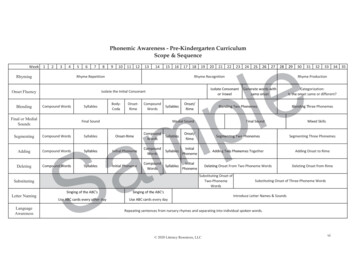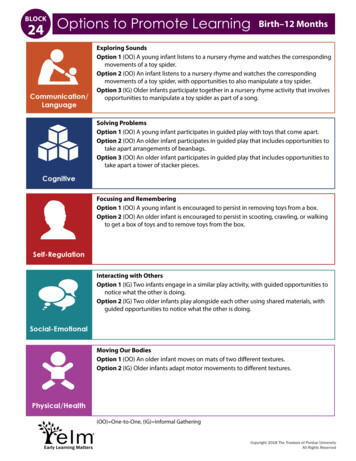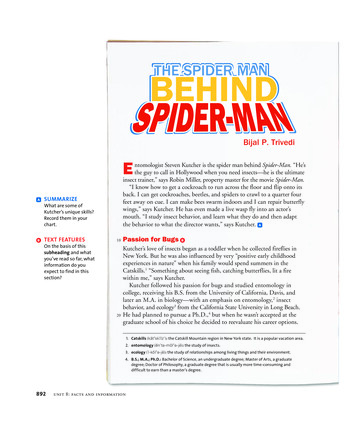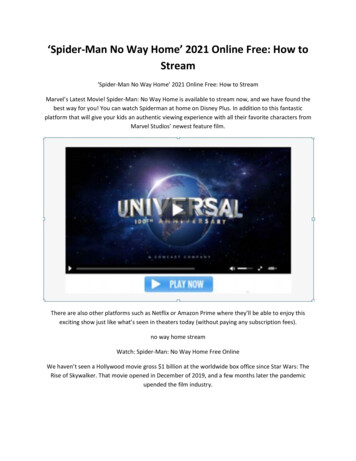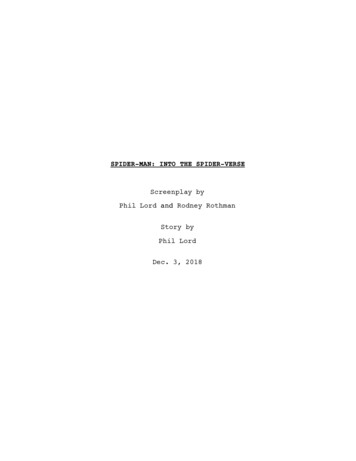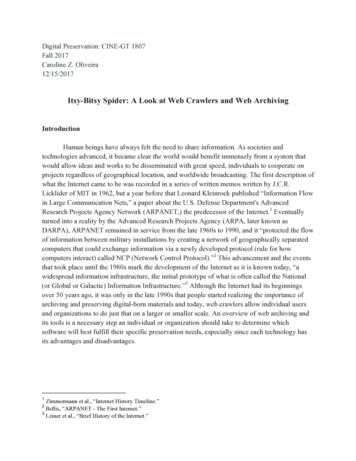
Transcription
Digital Preservation: CINE-GT 1807Fall 2017Caroline Z. Oliveira12/15/2017Itsy-Bitsy Spider: A Look at Web Crawlers and Web ArchivingIntroductionHuman beings have always felt the need to share information. As societies andtechnologies advanced, it became clear the world would benefit immensely from a system thatwould allow ideas and works to be disseminated with great speed, individuals to cooperate onprojects regardless of geographical location, and worldwide broadcasting. The first description ofwhat the Internet came to be was recorded in a series of written memos written by J.C.R.Licklider of MIT in 1962, but a year before that Leonard Kleinrock published “Information Flowin Large Communication Nets,” a paper about the U.S. Defense Department's AdvancedResearch Projects Agency Network (ARPANET,) the predecessor of the Internet.1 Eventuallyturned into a reality by the Advanced Research Projects Agency (ARPA, later known asDARPA), ARPANET remained in service from the late 1960s to 1990, and it “protected the flowof information between military installations by creating a network of geographically separatedcomputers that could exchange information via a newly developed protocol (rule for howcomputers interact) called NCP (Network Control Protocol).”2 This advancement and the eventsthat took place until the 1980s mark the development of the Internet as it is known today, “awidespread information infrastructure, the initial prototype of what is often called the National(or Global or Galactic) Information Infrastructure.”3 Although the Internet had its beginningsover 50 years ago, it was only in the late 1990s that people started realizing the importance ofarchiving and preserving digital-born materials and today, web crawlers allow individual usersand organizations to do just that on a larger or smaller scale. An overview of web archiving andits tools is a necessary step an individual or organization should take to determine whichsoftware will best fulfill their specific preservation needs, especially since each technology hasits advantages and disadvantages.1Zimmermann et al., “Internet History Timeline.”Bellis, “ARPANET - The First Internet.”3Leiner et al., “Brief History of the Internet.”2
Defining CrawlingCrawling or spidering is the process of “exploring web applications automatically[where] the web crawler aims at discovering the webpages of a web application by navigatingthrough the application, [which] is usually done by simulating the possible user interactionsconsidering just the client-side of the application.”4 In a more practical explanation, webcrawlers, which are also known as web spiders or web robots, are software that start out byvisiting a list of specific Universal Resources Locators, URLs. These URLs are called seeds andthe crawlers when used for archiving, copy and save the data associated with them. Next, thecrawler locates links associated with the URLs and adds them to the seed list. The archived datacan then be seen as snapshots of these websites and will not change if the live site gets updatedor changed unless the web crawler crawls it again.The Internet Archive and the Wayback MachineFor many decades, online content was disappearing just as fast as it was being created. Infact, “the average life of a web page is only 77 days,”5 and according to several studies: 80 % of web pages are not available in their original form after one year 13 % of web references in scholarly articles disappear after 27 months 11 % of social media resources, such as the ones posted on Twitter, are lost after oneyear.6With the Internet increasingly becoming indispensable in all aspects of human life,Brewster Kahle, Bruce Gilliat, and other technologists realized it was essential to preserve itscontent. In 1996 they founded the Internet Archive, a 501(c)(3) nonprofit organization that aimsto archive content from the World Wide Web on a scale that had never been attempted before.With preservation and access being its main focus, the Internet Archive was recognized as alibrary by the State of California, which solidified its association with other institutions thatshare the same objectives. On the other hand, the Archive differs from other traditional librariesfor its unique collection and for providing online access to all its materials and “by developingtools and services that help others make content in their own collections more widely available.”7Today the Archive manages: 279 billion web pages4Mirtaheri et al., “A Brief History of Web Crawlers.”“Internet Archive Wayback Machine.”6Costa, Gomes, and Silva, “The Evolution of Web Archiving.”7Rackley, “Internet Archive.”5
11 million books and texts4 million audio recordings (including 160,000 live concerts)3 million videos (including 1 million Television News programs)1 million images100,000 software programs.8Though the Archive has had many contributors since its creation, an importantinstitutional partner in its operations was Alexa Internet. Founded in 1996 by Kahle and Gilliat,the two men behind the Internet Archive itself, Alexa is a “web traffic information, metrics andanalytics provider”9 that promised to:Banish ‘404 not found’ messages for its members by retrieving stale pages from the[Internet Archive]. It [offered] guidance on where to go next, based on the traffic patternsof its user community -- putting in sidewalks where the footpaths are. Alexa also[offered] context for each site visited: to whom it's registered, how many pages it has,how many other sites point to it, and how frequently it's updated.10The Archive started using Alexa Internet’s proprietary crawler to capture content and in 2001 thetwo entities made the Wayback Machine, “a three-dimensional index that allows browsing ofweb documents over multiple time periods,”11 available to the public.The Wayback Machine allows users to visit archived versions of websites, but it is notinfallible. Certain pages contain broken links, missing images, or could not be archived at all.These are normally caused by: Robots.txt: A website’s robots.txt document will probably prevent crawling. Javascript: Javascript elements are normally difficult to capture and archive, butespecially if they produce links without having the full name on the web page. Playbackis also a concern. Server-side image maps: Similar to other functions on the Internet, if a page needs tocontact the originating server in order to make images load properly, it will not besuccessfully archived. Orphan pages -- If there are no links to the page in question, the crawler will not be ableto locate it.128“Internet Archive: About IA.”“What Is Alexa Internet?”10Dawson, “Alexa Internet Opens the Doors.”11“Internet Archive Frequently Asked Questions.”12Ibid.9
Archive-ItLaunched in 2006 by the Internet Archive, Archive-It is a subscription-based webarchiving service that assists various organizations to collect, construct, and preserve collectionsof digital materials. Currently, there are “over 400 partner organizations in 48 U.S. states and 16countries worldwide”13 that use this service. Users have access to their collections 24/7 and theability to perform full-text searches.Organizations that use Archive-It are able to determine the frequency and scope ofcrawls, produce reports, and customize Dublin Core metadata fields. In addition, the service“advertises the ability due to collect a wide range of content, including HTML, images, video,audio, PDF, and social networking sites,”14 with the data collected being stored in multipleservers as WARC (ARC) files.In fact, two copies of each created file are stored in the Internet Archive’s data centers,and Archive-It has partnerships with LOCKSS and DuraCloud, giving users a “trustworthydigital preservation program for web content.”15 Archive-It also prides itself on being able workwith organizations to deliver the best plan that meets their web archiving needs and budget.HeritrixAs mentioned previously, the Internet Archive used Alexa Internet’s proprietary crawler,but the software had its limitations. It was not able to perform crawls internally for the Archiveand it also did not facilitate cooperation between different institutions.16 In 2003, the Archivestarted developing an open-source, extensible, web-scale, archival-quality web crawler written inJava, which they named Heritrix.17 Heritrix, which is sometimes spelled heretrix, or completelymisspelled, aims to preserve and collect data to be utilized by future generations and adequatelygot its name from the archaic word for “heiress, or woman who inherits.”18 Currently, Heritrix ison its 3.2.0 version, which was released on January 2014, and it is said to be “most suitable foradvanced users and projects that are either customizing Heritrix (with Java or other scriptingcode) or embedding Heritrix in a larger system.”19In order to meet the Archive’s expectations, this new crawler needed to be able toexecute: Broad crawling: Broad crawls are high-bandwidth crawls that focus both on the numberof sites collected and the completeness with which any one site is captured. Broad crawls13“About Us.”“Archive-It.”15Slater, “Review: Archive-It.”16Mohr et al., “An Introduction to Heritrix - An Open Source Archival Quality Web Crawler.”17Rackley, “Internet Archive.”18“Heritrix - Home Page.”19Mohr and Levitt, “Release Notes - Heritrix 3.2.0.”14
attempt to take as many samples as possible of web pages given the time and storageresources available. Focused crawling: Focused crawls are small- to medium-sized crawls (usually less than10 million unique documents) in which the crawler focus on the complete coverage ofspecific sites or subjects. Continuous crawling: Unlike traditional crawling, which captures snapshot of specificsubjects, “downloading each unique URI one time only,” continuous crawling goes backto previously captured pages, looks for changes and updates, fetches new pages, andestimates how frequently changes are made. Experimental crawling: The Internet Archive and other organizations wanted toexperiment with different crawling techniques, being able to control what to crawl, orderin which resources are crawled, crawling while using different protocols, and analysisand archiving of crawl results.20As mentioned previously, Java was chosen as the software language due to its largedeveloper community and open source libraries. Java also “offers strong support for modulardesign and components that are both incrementally extendable and individually replaceable,”21characteristics that would help the Archive accomplish its objectives. When it comes to itsarchitecture, Heritrix was designed to be pluggable and allow customization and contributionsfrom different parties, both which help when performing different types of crawling.However, Heritrix is not without flaws. Currently, it does not support continuouscrawling and it is not dynamically scalable, which means one needs to determine the number ofservers taking part in the scheme before one can start crawling. Furthermore, “if one of themachines goes down during your crawl you are out of luck.”22 Heritrix also lacks in flexibilitywhen it comes to output options, only exporting ARC/WARC files. WARC or Web ARChivefile format is the successor of ARC, a “format that has traditionally been used to store ‘webcrawls’ as sequences of content blocks harvested from the World Wide Web”23 and for now,writing data to other formats would require changes in the source code. WARC, an ISO format,ISO 28500:2009, has four required fields: Record identifier (i.e., URI): A globally unique identifier assigned to the currentWARC record. Content length/ record body size: The length of the following Record ContentBlock in bytes (octets). Date: A timestamp in the form of YYYY-MM-DD and hh:mm:ss indicating whenthe record was created.20Mohr et al., “An Introduction to Heritrix - An Open Source Archival Quality Web Crawler.”Ibid.22Pedchenko, “Comparison of Open Source Web Crawlers.”23“WARC, Web ARChive File Format.”21
WARC record type: The WARC Format Standard supports the ‘warcinfo’,‘response’, ‘resource’, ‘request’, ‘metadata’, ‘revisit’, ‘conversion.’24One of the primary issues with this format, however, is the problem of scalability, “especially forcontent that needs to be manually inputted to be compatible with Preservation Metadata:Implementation Strategies (PREMIS).”25HTTrack and WgetCurrently, Heritrix is one of the most popular web crawlers for web archiving, but otherinstitutions also use HTTrack and Wget. HTTrack Website Copier is a free offline browserutility, which enables the user to download the contents of entire websites from the Internet to alocal directory for offline viewing by “building recursively all directories, getting HTML,images, and other files from the server to [a] computer.”26 However, HTTrack is not perfect.Many of its users complain this crawler is very slow and although the offline browsing worksadequately for flat HTML, the user “will need appropriate web-server technologies installed forscripting, JAVA, PHP, or other server-side includes to work.”27To operate HTTrack, the user starts out by choosing a filename and a destination folderfor the project. The next step is to select an action, which can be to simply download a website,download the website and ask the user if any links are potentially downloadable, only downloaddesired files, download all the sites in pages, test all indicated links, continue an interrupteddownload, or update an existing download.28 Before the user is able to start downloading, he orshe is able to determine if they want to start the process immediately or at a later date andindicate if he or she wants the server to disconnect after the download is completed or even shutdown the computer. Finally, log files generated by HTTrack allow the user to identify potentialerrors.Just like other crawlers, HTTrack has its limitations. Currently, it cannot handle: Flash sites.Intensive Java/Javascript sites.Complex CGI with built-in redirect, and other tricks.Parsing problem in the HTML code (cases where the engine is fooled, forexample by a false comment ( !--) which has no closing comment (-- ) detected.2924“The WARC Format Explained.”Corrado and Sandy, Digital Preservation for Libraries, Archives, and Museums.26“HTTrack Website Copier.”27Catling, “Review.”28“HTTrack Website Copier - Offline Browser.”29“F.A.Q.”25
Though HTTrack’s Frequently Asked Questions page is extensive and detailed, it seems that themain concern regarding this crawling tool is its slow speed in completing a project and openingthe saved pages. Based on its low cost and functionality, HTTRack is considered an adequatetool for archiving and can be useful to smaller institutions.Wget is “a free software package for retrieving files using HTTP, HTTPS, FTP, andFTPS the most widely-used Internet protocols [and] it is a non-interactive command line tool, soit may easily be called from scripts, cron jobs, terminals without X-Windows support, etc.”30 Inother words, Wget does not require the user to be logged on in order for it to work.This software was also designed to work with slow or unstable network connections. Incase the network is faulty and the download fails, Wget “will keep retrying [to connect] until thewhole file has been retrieved.”31BrozzlerBrozzler, which got its name from the mash of the words crawler and browser, wasdeveloped with a grant from the Andrew W. Mellon Foundation to improve the capture of audioand video in web archiving. According to Levitt, there are two categories of challenges when itcomes to capturing audio-visual materials: Issues specific to audio-visual media (e.g. streaming formats) General web crawling challenges (e.g. discovering URLs generated byJavascript).32To assist with the first issue, Brozzler uses youtube-dl, a command-line program that downloadsvideos and audio files from streaming websites such as YouTube.com, Vimeo, and Dailymotion.It can be operated on Linux, Windows, and Mac OS X systems, but it requires Pythoninterpreter, version 2.5 or higher, Chromium or Google Chrome browser, and RethinkDB, opensource, scalable database, deployment to work.33For the second issue, Brozzler uses a real browser (chrome or chromium) to load webpages, in fact, it “differs from Heritrix and other crawling technologies in its reliance on anactual web browser to render and interact with web content before all of that content indexed andarchived into WARC files.”34Brozzler is also designed to work in conjunction with warcprox. Reviews on this softwareare still hard to find so it will be interesting to see if users will be satisfied with it.30“GNU Wget.”“GNU Wget 1.18 Manual.”32Levitt, “Brozzler.”33Brozzler.34Lohndorf, “Archive-It Crawling Technology.”31
Webrecorder and “Human-Centered” Web ArchivingFounded by the Andrew W. Mellon Foundation, Rhizome released in 2016 the firstpublic version of its Webrecorder, a free online tool that aims to tackle the issue of archivingchallenging digital content. Developed by the company in partnership with programmer IlyaKreymer, Webrecorder is “a human-centered archival tool to create high-fidelity, interactive,contextual archives of social media and other dynamic content, such as embedded video andcomplex javascript.”35 Since most tools in web archiving deliver static files when crawlingwebsites, they are unable to capture material that keeps changing or being constantly updated,such as social media websites. Furthermore, a regular crawler is unable to capture the wholeexperience of a website, since it cannot browse a site as a real user would. Although crawlers arefaster, they make:Decisions based on certain heuristics, and often times it [does not] run javascript, andeven if it does, it follows a specific pattern, and [cannot] use the site the way an actualuser would. And so, the archive of the site is often incomplete, and different than how anactual user would use the site.36Internet users are advised to sign up for a free account with 5GB of storage space atwebrecorder.io. and it is possible to download the Webrecorder Desktop Player Application,which allows the users to browse through their archived material offline. However, one can alsoutilize the software without registering and create temporary collections anonymously. Webarchives created with the software are downloaded as WARC files, which come with all therequired metadata mentioned previously in the Heritrix section. In fact, existing standardWARC (or ARC) files can be imported into Webrecorder and added to collections.37The process of creating the recordings seems to be flexible. Each time a user hits the“record” button, the software creates recording sessions, which are the smallest units of a webcollection in Webrecorder. The user is able to add multiple recordings to a single collection,rename, move, and even delete files.Webrecorder is a free open-source software, but users should be aware of its terms andpolicies. In its “Terms of Use,” Rhizome makes it clear it has the right “to terminate or restrictaccess to [one’s] account and to delete or disable access to any links created and/or contentstored in connection with the account, in [their] sole discretion, without advance notice, and shallhave no liability for doing so.”38 Rhizome also notes that it reserves the right to suspend servicewithout telling its users beforehand. These aspects could certainly generate many issues for anindividual or repository that depend on this software to meet his/its web archiving needs.35“Rhizome Awarded 600,000 by The Andrew W. Mellon Foundation to Build Webrecorder.”McKeehan, “Symmetrical Web Archiving with Webrecorder, a Browser-Based Tool for Digital Social Memory.An Interview with Ilya Kreymer.”37Espenschied, “Rhizome Releases First Public Version of Webrecorder.”38“Terms and Policies.”36
Another aspect that could be considered a disadvantage of the Webrecorder is directlyrelated to its human-centricity. To operate the software, a user has to browse the desired websiteafter pressing Webrecorder’s record button. Consequently, the user has to manually open everylink, play every video, and access all different parts of the website in order for it to be archivedentirely. For this reason, the process can be very time consuming.Challenges of Web ArchivingEvery form of archiving poses challenges and web archiving is no different. Not only isthe web constantly changing, but there are also websites that were not built to be archived at all.Although web crawlers have made a lot of progress with their capturing abilities, according toJillian Lohndorf, web archivists still have to deal with the following issues: Streaming and Downloadable Media: Although some crawlers are able to capture thistype of media, playback is still an issue, especially on websites that have a large volumeof videos and media. Password-Protected Websites: These websites were especially designed to avoid outsideusers from accessing its information. Apparently, there are ways some crawlers (likeHeritrix) can access these protected sites, but the user has to use his or her logininformation to access the content before being able to initiate the crawl. Form and Database-Driven Content: If the user has to execute an action to interact with awebsite (i.e., use its search bar), crawlers might not be able to properly capture itscontents. Lohndorf also notes that Archive-It has a particularly difficult time trying tocapture websites with POST requests, which “[submit] data to be processed to a specifiedresource.”39 Robots.txt Exclusions: Certain websites might have been designed to prevent crawling alltogether. These websites in question have a robot.txt exclusion and crawlers tend torespect that by default. However, there are ways users can set up rules to ignore theserobots either by contacting the webmaster to ask for an exception or, in Heritrix’s case,the crawler’s support team. Dynamic Content: Many crawlers are able to capture websites with dynamic content, butagain, playback remains an issue. There are also certain types of content that are stilldifficult to archive, including: Images or text size that adjust accordingly to the size of the browser Maps that allows the user to zoom in and out Downloadable files Media with a “play” button Navigation menus 403940“HTTP Methods GET vs POST.”Lohndorf, “5 Challenges of Web Archiving.”
ConclusionAlthough it can still be considered a recent endeavor, web archiving has become anindispensable activity in today’s world. People are constantly uploading photos, sharing theirthoughts and ideas, and seeking answers to their questions in all sorts of websites, all of whichmake the Internet an important tool in understanding current and past cultural and socioeconomic trends. Founded in the 1990s, the Internet Archive aimed to preserve the contents ofthe web, make all of its collections available to the public, and provide services that would allowother institutions to capture their own materials. Through the years, it has launched the WaybackMachine, Archive-It, and Heritrix, an open-source crawler that has been widely used all over theworld. In fact, users currently have several options when it comes to finding a web crawler tomeet their preservation needs. Besides Heritrix, a user might find HTTrack, a free offlinebrowser, or Wget, a non-interactive command line tool, more user-friendly and capable ofhandling smaller operations. Other options include Brozzler, which uses a real browser duringcrawls, and Webrecorder, an operation that records the user’s interaction with a web page. Nomatter which crawler the user or the organization might end up opting for, it is important torecognize the challenges and limitations related to web archiving in general, such as itsdifficulties in capturing and executing playback for dynamic content and downloadable media,dealing with websites that contain robots.txt exclusions, crawling password-protected sites, andhandling form and database-driven content. However, since technological advances are beingmade every day, many believe that soon web crawlers will be able to fully capture all differentaspects of web pages, allowing organizations to preserve one of the most ephemeral andmutating services in current society, the Internet.
Bibliography“About Us.” Archive-It Blog (blog). Accessed November 5, 2017. https://archive-it.org/blog/learnmore/.“About Us.” Archive-It. Accessed December 11, 2017. -It.” Digital Curation Centre. Accessed December 11, ve-it.Bellis, Mary. “ARPANET - The First Internet.” The Cold War and ARPANET. Accessed December9, 2017. http://ocean.otr.usm.edu/ w146169/bellis.html.Brozzler: Distributed Browser-Based Web Crawler. Python. 2015. Reprint, Internet Archive, atling, Robin. “Review: WebHTTrack Website Copier and Offline Browser (Re-Post).” EverythingExpress (blog), February 20, 2010. er-re-post/.Corrado, Edward M., and Heather M. Sandy. Digital Preservation for Libraries, Archives, andMuseums. Second Edition. Rowman & Littlefield Publishers. Accessed November 20, 2017.https://books.google.com/books?id 7GnEDQAAQBAJ&pg PA292&lpg PA292&dq wget preservation&source bl&ots bcUNQ16LpV&sig asIDMyfd5t45Oy8aKlLTZwDhy4&hl en&sa X&ved 0ahUKEwjNvP6kvM3XAhUE4CYKHf2aA0Q6AEISDAG#v onepage&q wget%20preservation&f false.Costa, Miguel, Daniel Gomes, and Mário J. Silva. “The Evolution of Web Archiving.” SpringerVerlag, May 9, 2016. tent/pdf/10.1007%2Fs00799-016-0171-9.pdf.Dawson, Keith. “Alexa Internet Opens the Doors.” Tasty Bits from the Technology Front, July 27,1997. penschied, Dragan. “Rhizome Releases First Public Version of Webrecorder.” Rhizome, August 9,2016. .Q.” HTTrack Website Copier - Offline Browser. Accessed December 10, �GNU Wget.” GNU. Accessed November 19, 2017. https://www.gnu.org/software/wget/.“GNU Wget 1.18 Manual.” Accessed December 11, .html.
Gonzalez, Ricardo Garcia. “Youtube-Dl.” GitHub. Accessed December 10, 2017.https://rg3.github.io/youtube-dl/.“Heritrix - Home Page.” Accessed November 17, 2017. http://crawler.archive.org/index.html.“HTTP Methods GET vs POST.” Accessed December 11, 2017.https://www.w3schools.com/tags/ref httpmethods.asp.“HTTrack Website Copier.” Accessed November 19, 2017. https://www.httrack.com/.“HTTrack Website Copier - Offline Browser.” Accessed December 10, Track/WebHTTrack.” Accessed December 10, rack.“Internet Archive: About IA.” Accessed November 12, 2017. https://archive.org/about/.“Internet Archive Frequently Asked Questions.” Accessed November 17, 2017.http://archive.org/about/faqs.php#The Wayback Machine.“Internet Archive Wayback Machine.” Accessed November 11, aq.html#wayback what is.Leiner, Barry M., Vinton G. Cerf, David D. Clark, Robert E. Kahn, Leonard Kleinrock, Daniel C.Lynch, Jon Postel, Larry G. Roberts, and Stephen Wolff. “Brief History of the Internet.” InternetSociety (blog). Accessed December 9, 2017. ternet/brief-history-internet/.“Leonard Kleinrock And The ARPANET.” Accessed December 9, 2017.https://www.livinginternet.com/i/ii kleinrock.htm.Levitt, Noah. “Brozzler.” Keynote Speech presented at the IIPC Building Better Crawlers Hackathon,British Library, London, UK, September 22, 2016. http://archive.org/ nlevitt/reveal.js/#/.Lohndorf, Jillian. “5 Challenges of Web Archiving.” Archive-It Help Center. Accessed November 5,2017. t Crawling Technology.” Archive-It Help Center. Accessed November 4, eehan, Morgan. “Symmetrical Web Archiving with Webrecorder, a Browser-Based Tool forDigital Social Memory. An Interview with Ilya Kreymer.” Accessed December 10, er/.
Mirtaheri, Seyed M., Mustafa Emre Dincturk, Salman Hooshmand, Gregor V. Bochmann, and GuyVincent Jourdan. “A Brief History of Web Crawlers.” University of Ottawa, May 5, 2014.https://arxiv.org/pdf/1405.0749.pdf.Mohr, Gordon, and Noah Levitt. “Release Notes - Heritrix 3.2.0.” Heritrix. Accessed November 17,2017. ages/13467786/Release Notes Heritrix 3.2.0.Mohr, Gordon, Michael Stack, Igor Ranitovic, Dan Avery, and Michele Kimpton. “An Introduction toHeritrix - An Open Source Archival Quality Web Crawler,” f.Pedchenko, Aleks. “Comparison of Open Source Web Crawlers.” Aleks Pedchenko (blog), April 6,2017. ource-web-crawlers62a072308b53.Rackley, Marilyn. “Internet Archive.” In Encyclopedia of Library and Information Sciences, ThirdEdition., 2966–76. Taylor & Francis, 2009. me Awarded 600,000 by The Andrew W. Mellon Foundation to Build Webrecorder.”Rhizome, January 4, 2016. er-mellon/.Slater, Jillia
archiving and preserving digital-born materials and today, web crawlers allow individual users . of web archiving and its tools is a necessary step an individual or organization should take to determine which software will best fulfill their specific preservation needs, especially since each technology has . 11 % of social media resources .
